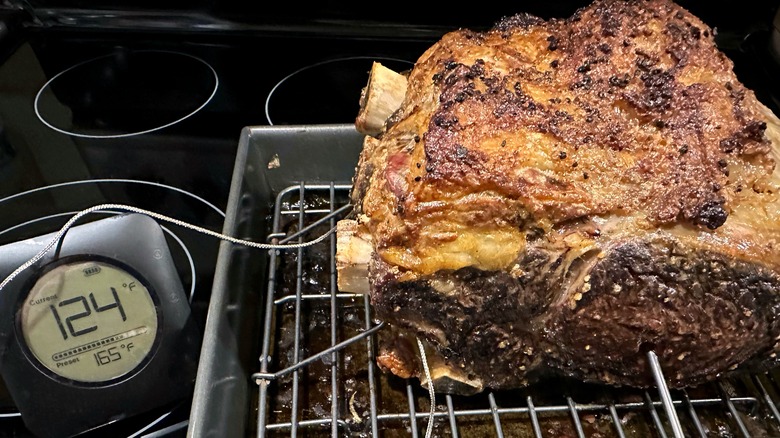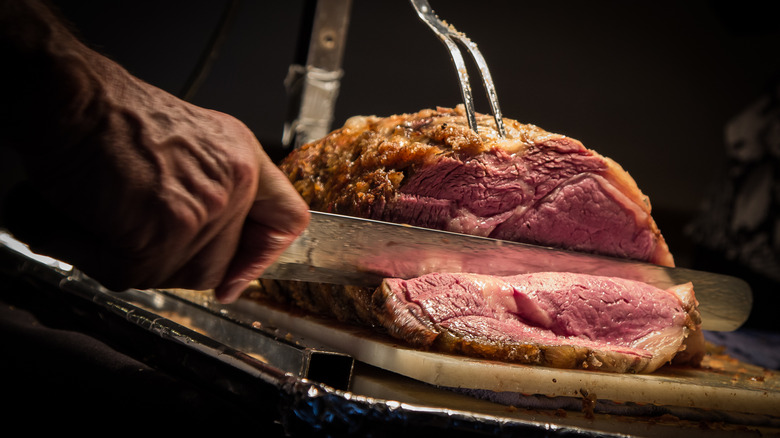David Rose's Prime Rib Tip That Prevents Tough Meat Every Time
Prime rib is a majestic cut of meat. Achieving a perfectly browned roast with a medium or rare interior is a true culinary triumph. Unfortunately, many home cooks need several rounds of trial and error to perfect this cut of beef. Given its popularity during the holidays and its higher price point, hosts are eager to accelerate their learning curve.
Thankfully, David Rose, the executive chef for Omaha Steaks, offers a helpful tip for nailing this rich dish. Instead of roasting the prime rib to the ideal doneness, remove it early and let it sit at room temperature for the final stage of cooking. This approach allows the internal temperature to rise even after it's removed from the oven. As a bonus, the resting time helps the meat retain its flavorful juices, preventing them from leaking out when carved, and ensuring the beef remains tender.
"If you want it medium, you want to take it out at medium rare," Rose explained in an exclusive interview with Mashed. He recommends a 20-minute rest for the meat, allowing the residual heat to continue cooking the tender prime rib. "That way, when it gradually climbs, it'll be that perfect medium temperature."
Harnessing the power of carryover cooking
Cooks may wonder how their meat can finish cooking when it's no longer under direct heat. The explanation is that the warmth from a hot oven or grill, absorbed by the roast's exterior, continues to penetrate the interior flesh while it rests. This phenomenon, known as "carryover cooking," occurs only when a protein is subjected to high temperatures — it's not something you'll see with low-and-slow cooking methods.
To effectively utilize this technique for your next prime rib roast, you'll need a meat thermometer to achieve precise results. Monitor your beef to ensure it reaches 5 to 15 degrees Fahrenheit below your desired final temperature, depending on how high you've cranked your oven. For instance, rather than waiting for the prime rib to reach a medium doneness (140 to 145 degrees Fahrenheit) in the oven, remove it at 125 to 130 degrees Fahrenheit, allowing the medium-rare roast to continue warming.
Don't underestimate the effectiveness of carryover cooking when it comes to browning or reverse searing your crust. After cooking at a lower temperature or resting the meat, a final quick burst of high heat can create a rich, browned exterior without compromising the tender interior. However, be cautious not to reheat leftovers in the microwave carelessly; one of the worst mistakes when it comes to prime rib is turning a perfectly pink center into a gray, tough slab.
Carving tender prime rib roast
Another moment of celebration after a lengthy cooking process is carving into the exquisite marbled meat. To appear cool, calm, and collected while handling prime rib, ensure your station is prepared for the task. Whether you've chosen a bone-in or boneless cut, start by verifying that your carving knife is sharp. This guarantees clean cuts, and simplifies the task of carving the tender beef.
For a firm grip, utilize a carving fork — an oversized metal utensil with two prongs — to anchor the browned meat. Some cooks also trim a small piece off the meat's base to create a flatter surface that sits more securely on the cutting board, preventing any wobble. Alternatively, you may opt to detach the bones with a boning knife before carving, which eliminates the need to maneuver around them.
Keeping the bones intact can serve as a visual guide while you slice, although you can also judge the portions by eye. David Rose prefers to leave the bones in, aiming for slices about one inch thick. In some homes, thinner half-inch slices are favored, while others prefer more generous cuts. However you slice it, remember to go against the grain, and save the bones and browned end pieces — they offer a delicious treat for select guests, or can be used as ingredients for soup.
Static Media owns and operates Food Republic and Mashed.



